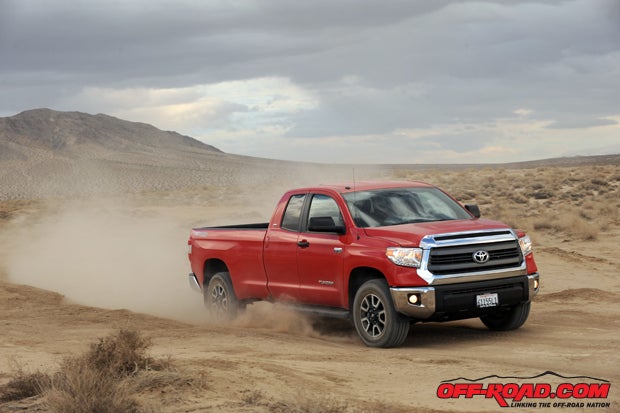
When Toyota redesigned the Tundra in 2007, the company trumpeted its new half-ton truck to the masses. It was tougher, stronger, more durable, and most importantly, Toyota felt it was worthy of being in the conversation with the “big three” (Chevy, Ford, Ram) for American truck buyers. It was Toyota’s full-fledged half-ton truck that was first conceptualized with the T100 and fully realized in the second-generation Tundra in 2007.
Toyota now enters 2014 with its third-gen Tundra, which the company hopes will continue to improve its standing in the half-ton market. Although produced by a Japanese-based company, Toyota has worked hard to instill as much “American made” in the Tundra as possible. The changes found on the 2014 Tundra were engineered at the Toyota Center in Ann Arbor, Michigan, its V6 and V8 powerplants are produced at its plant in Alabama, its transmissions produced in North Carolina, and then its mostly American-made parts are then assembled in San Antonio, Texas.
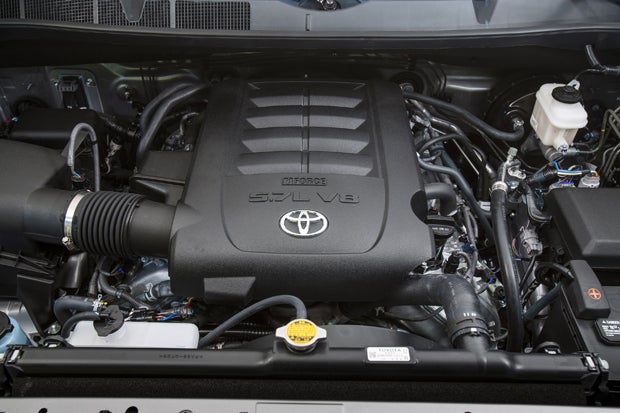
As for the new look of the 2014 Tundra, Toyota enlisted Calty Design Research centers, which has locations in Newport Beach, California, and Ann Arbor, Michigan, with a focus on creating a new “bold and powerful” exterior. The changes can be found with a new integrated hood and grille design, with the grille itself being taller and more pronounced. The lower bumpers now feature a three-piece design for lower replacement costs should a section get dinged, while the fenders and wheel wells are more squared off to shine the spotlight on Tundra’s wide stance. The bed design helps carry the “chiseled” look with its tighter lines. Out back, a new tailgate is fitted with a bold TUNDRA stamped into the sheet metal.
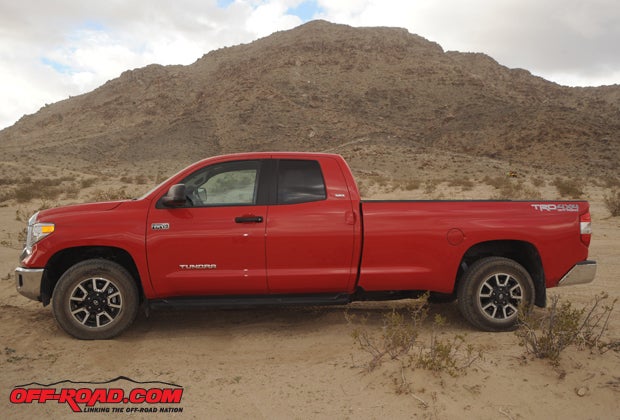
The Tundra’s interior received the most changes for 2014, with a new dash, new steering wheel, redesigned center stack with smaller control knobs for the A/C and redesigned vents across the dash. The center storage console also has also been redesigned as well, and the very plush 1794 model (another Americana reference to the ranch that once stood where its San Antonio plant now resides) is designed to be on par with a Ram Laramie Longhorn, GMC Sierra Denali or Ford F-150 King Ranch.
Changes, No Changes
There are no major changes to the engines on the 2014 Tundra, though sister site AutoGuide.com has stumbled across the fact that it may come with a Cummins diesel in 2016. Three options are available for the ‘14, including a 4.0-liter DOHC V6 (276 hp @ 5,600 rpm, 278 lb.-ft. of torque), a 4.6-liter DOHC i-Force V8 (310 hp @ 5,600 rpm, 327 lb.-ft. of torque), and the 5.7-liter DOHC i-Force V8 (381 hp 2 5,600 rpm, 401 lb.-ft. of torque). The V6 is paired with a five-speed automatic transmission and is rated 16 mpg city, 20 mph highway. The V8s come standard with a six-speed automatic transmission that is electronically controlled, with the 4.6-liter having a 14 city/18 highway fuel economy rating and the 5.7-liter 13 city/17 highway.
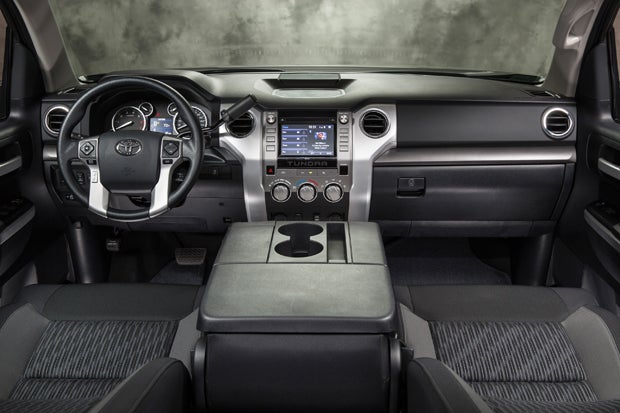
As for the ride, Toyota did retune the valving on the shocks to improve handling, while steering system updates help improve straight-line stability of the Tundra. Patented “Aero-Fins” are designed to help with aerodynamics on the Tundra as well for straight-line tracking both for normal driving and towing. Cabin noise was also reduced on the new Tundra thanks to a number of insulation changes and sound-absorbing parts.
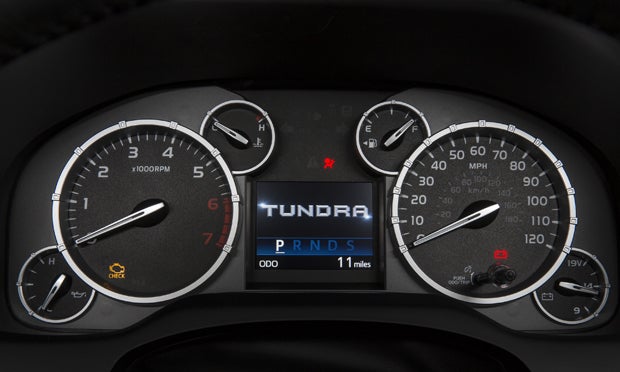
Stopping power on the Tundra is still employed by four-wheel disc brakes with vented rotors, while Anti-lock Brakes (ABS), Electronics Brake-force Distribution (EBD) and Brake Assist (BA) are standard on all Tundra models. On 4x4 models, Toyota features a six-pinion planetary reduction gear set to offer 4x2, 4x4 Hi and 4x4 Lo settings that are controlled via a dial on the dash.
When it comes to towing, Toyota points out it is the only full-sized truck to have adopted the SAE J2807 towing standard since 2011, which essentially is a rating for towing performance that includes such criteria as needing to accelerate to 30 mph in 12 seconds or less, climbing particular elevation changes without dropping below a certain speed, and much more. Toyota says that when equipped with a tow package, the Tundra has a towing capacity of 10,400 pounds (4x2 Regular cab), though the TRD 4x4 Double Cab unit we tested has a slightly lower maximum of 9,800 pounds. In spite of its J2807 certification, the Tundra does come equipped with an integrated brake controller.
One across-the-board upgrade is a standard backup camera on all Tundras. Engineers also pushed the rear license plate lights out further to provide an improved view of the trailer-light connector for easier nighttime connections.
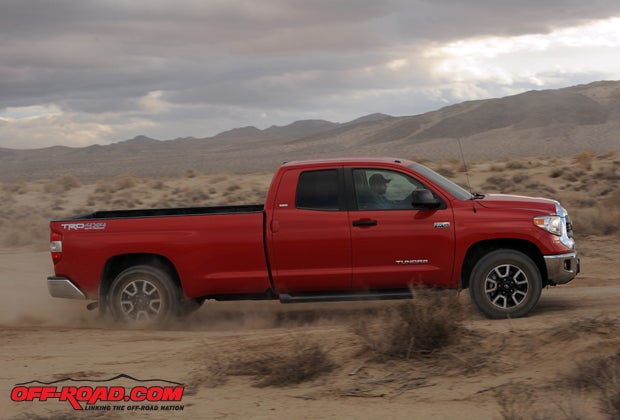
How it Stacks Up
For our test, we picked up a 4x4 Double Cab Long Bed Tundra equipped with the SR5 and TRD packages and powered by the 5.7-liter motor. As equipped, our truck has an MSRP of $39,260. Although not quite capable of tackling more aggressive trails (due to clearance issues and road tires), the TRD-equipped Tundra is the most off-road savvy of the standard Tundra offerings (the 2015 TRD Pro models coming next year will be even more capable). The TRD package includes an engine skid plate, fuel tank skid plate, rear-side privacy glass, 18-inch TRD alloy wheels, and most importantly, upgraded Bilstein shocks. Toyota did make some upgrades to its shock valving across the board, and the TRD Bilsteins are no exception, as Toyota adjusted the front and rear spring rates and revalved the Bilstein shocks for improved on-road ride without sacrificing off-road performance. Our 4x4 model also features an auto limited-slip differential for added traction in off-road driving.
When we first picked up the unit and drove around town, it’s clear there’s a slightly different feel to the third-generation Tundra compared to the second gen (’07-13). The revisions to the steering ensure the Tundra tracks straight on the highway, though we can’t help but feel the steering is slightly less responsive in turns compared with the previous model. The turning is smooth no doubt, as is the overall handling, but it doesn’t feel quite as responsive as the gen-two model when cornering.
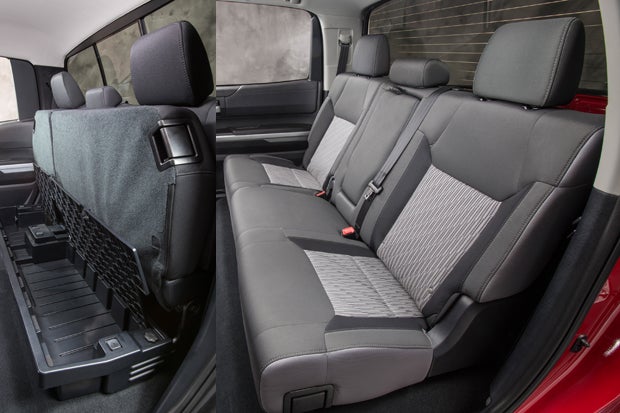
One excellent feature of the Tundra is its turning radius, which is quite impressive for such a large truck. It does not require three-point turns during u-turns at most intersections, and maneuvering into parking spots at the market is not a daunting task. Overall, the Tundra handles smoothly and confidently on the road and in tighter quarters.
The 2014 Tundra traveled with us to the 2014 King of the Hammers, and its longer eight-foot bed (97.6 inches, to be exact) certainly served our needs, as we loaded up KTM and Beta dual-sport bikes with plenty of room to close the tailgate and load other gear. Since our Tundra was equipped with the tow package, we also used it to pull a flatbed trailer loaded with a Kawasaki Teryx4 and a Yamaha Viking. The weight of the load, including trailer and side-by-sides, was approximately 5,000 pounds. Even with the bikes and loaded trailer, we were still well under the 9,800-pound tow capacity for our model. Much higher, and a trailer brake would be ideal, but as is, more weight doesn’t appear it would pose any trouble to the 5.7-liter motor.
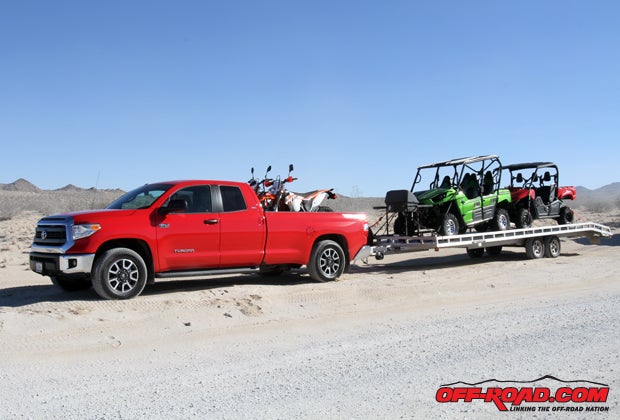
The Tundra pulled our load confidently. The 5.7-liter motor offers an immediate punch of acceleration and quickly gets the truck to speed, and while climbing steeper grades, such as the Cajon Pass on the 15 en route to Johnson Valley, the Tundra showed absolutely no signs of struggle – in fact, this is one area where it shined. The backup camera is a great feature for towing as well, as its wide view makes backing up to attach the receiver a cinch.
Once out in Johnson Valley, we disconnected the trailer and took the 4x4 out and around Hammertown and the Means Dry Lake bed. The Tundra is more than capable in the dirt, with ample power and 4x4 capability, though the biggest drawback for any serious playtime is clearance, meaning off-roaders will look toward the aftermarket or the 2015 TRD Pro models if they plan to truly play. With a few more inches of clearance and some more aggressive tires, the Tundra would be right at home in most off-road conditions and not just pulling the toys out to the spot.
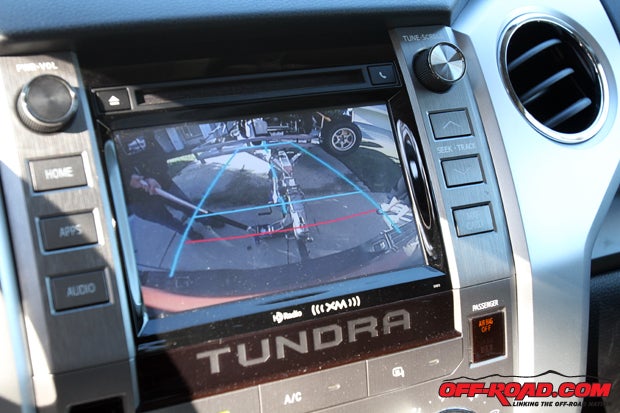
The 4x4 Double Cab Tundra we tested has a combined fuel rating of 15 mpg (13 city, 17 highway). While towing to and from Johnson Valley, the Tundra averaged 10.2 mpg towing our 5,000-pound trailer load and extra 700-800 pounds of dirt bikes and gear in the bed. For just pure highway travel, we did produce an impressive – and surprising – 19.8 mph rating during one stretch, though this was without much headwind and on relatively flat freeway with no major hills. Realistically, the 15 mpg rating appears accurate, and this might be one of the toughest selling points for the Tundra. With many manufacturers moving toward more fuel-efficient motors, be it with supercharged V6 motors or turbo-diesel options, Toyota decided to stay put with its tried-and-true i-Force V8s and V6 offerings. Don’t get us wrong, the 5.7-liter V8 can tackle just about anything you can throw at it, but you’ll have to be comfortable with paying a little more at the pump.
The new 2014 Tundra marks the third generation of Toyota’s push in the half-ton truck market. While the second-gen Tundra marked a quantum leap for the Tundra, the jump from 2013 to the new 2014 is far less dramatic. The new Tundra represents more of a number of smaller tweaks, and other than the new styling none of them are likely to push non-Toyota fans into the Tundra. That said, Toyota has built a solid reputation for dependability, and the previous Tundras, with the 5.7-liter motor leading the way, have proven their worth. The question comes down to whether the new tweaks are enough to move the needle for those on the fence.


 Your Privacy Choices
Your Privacy Choices